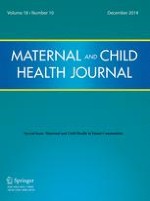Published in:

01-12-2014
Dietary Habits and Supplement Use in Relation to National Pregnancy Recommendations: Data from the EuroPrevall Birth Cohort
Authors:
E. M. Oliver, K. E. C. Grimshaw, A. A. Schoemaker, T. Keil, D. McBride, A. B. Sprikkelman, H. S. Ragnarsdottir, V. Trendelenburg, E. Emmanouil, M. Reche, A. Fiocchi, A. Fiandor, A. Stanczyk-Przyluska, J. Wilczynski, M. Busacca, S. T. Sigurdardottir, R. Dubakiene, O. Rudzeviciene, G. D. Vlaxos, K. Beyer, G. Roberts
Published in:
Maternal and Child Health Journal
|
Issue 10/2014
Login to get access
Abstract
Assessing maternal dietary habits across Europe during pregnancy in relation to their national pregnancy recommendations. A collaborative, multi-centre, birth cohort study in nine European countries was conducted as part of European Union funded EuroPrevall project. Standardised baseline questionnaire data included details of food intake, nutritional supplement use, exposure to cigarette smoke during pregnancy and socio-demographic data. Pregnancy recommendations were collected from all nine countries from the appropriate national organisations. The most commonly taken supplement in pregnancy was folic acid (55.6 % Lithuania–97.8 % Spain) and was favoured by older, well-educated mothers. Vitamin D supplementation across the cohort was very poor (0.3 % Spain–5.1 % Lithuania). There were significant differences in foods consumed in different countries during pregnancy e.g. only 2.7 % Dutch mothers avoided eating peanut, while 44.4 % of British mothers avoided it. Some countries have minimal pregnancy recommendations i.e. Lithuania, Poland and Spain while others have similar, very specific recommendations i.e. UK, the Netherlands, Iceland, Greece. Allergy specific recommendations were associated with food avoidance during pregnancy [relative rate (RR) 1.18 95 % CI 0.02–1.37]. Nutritional supplement recommendations were also associated with avoidance (RR 1.08, 1.00–1.16). Maternal dietary habits and the use of dietary supplements during pregnancy vary significantly across Europe and in some instances may be influenced by national recommendations.
